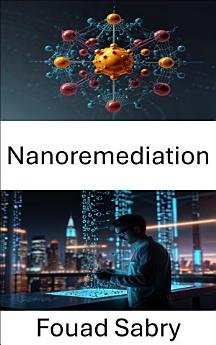Nanoremediation: Advancing Environmental Restoration Through Innovative Nanotechnology Solutions
About this ebook
Pollution from nanomaterials-This chapter explores the potential environmental risks posed by nanomaterials, addressing both their beneficial and harmful aspects, and the balance that needs to be achieved for safe application
Titanium dioxide nanoparticle-A deep dive into titanium dioxide nanoparticles, detailing their role in environmental remediation and their widespread use in cleaning air and water from pollutants
Green nanotechnology-This chapter highlights the emergence of green nanotechnology and its sustainable approach to addressing environmental concerns through nanoremediation processes that are both effective and ecofriendly
Arturo A. Keller-Focusing on Arturo A. Keller’s contributions, this chapter outlines his groundbreaking research and its impact on advancing nanoremediation strategies in realworld applications
Mercury nanotrap water filtration-The exploration of mercury nanotrap water filtration technologies and their importance in removing mercury contamination from water bodies, a major environmental challenge
Groundwater remediation-Groundwater contamination is tackled through innovative nanoremediation techniques, emphasizing the importance of restoring clean water sources and ensuring sustainable water supply
Laurent Charlet-A look at Laurent Charlet’s influential work, particularly in the context of nanotechnology’s role in addressing contaminated water and soil through novel remediation methods
Environmental remediation-An overview of the broader field of environmental remediation, showing how nanotechnology fits into current trends and future possibilities for solving global pollution issues
Jacqueline Quinn (engineer)-This chapter explores Jacqueline Quinn’s engineering approach to nanoremediation, providing case studies and examples of her work to demonstrate the application of nanotechnology in realworld environmental issues
In situ chemical oxidation-A discussion on in situ chemical oxidation, explaining its role in treating contaminated environments through nanotechnologyassisted reactions that break down harmful pollutants in place
Electrical resistance heating-The use of electrical resistance heating as a remediation technique, highlighting how nanotechnology can enhance the effectiveness of this method in remediating hazardous waste sites
Regulation of nanotechnology-An important chapter that addresses the regulatory landscape of nanotechnology, discussing the policies, guidelines, and challenges in ensuring safe deployment of nanoremediation technologies
1,2,3Trichloropropane-The focus here is on the remediation of toxic chemicals such as 1,2,3Trichloropropane, using advanced nanotechnology techniques to detoxify hazardous substances in the environment
In situ chemical reduction-This chapter examines in situ chemical reduction as a nanotechnology application for environmental cleanup, discussing its practical uses and effectiveness in treating soil and groundwater contamination
Air sparging-Air sparging is explored as a technique for removing volatile contaminants from groundwater, with a focus on how nanotechnology improves its efficiency and environmental benefits
Nanotoxicology-Nanotoxicology looks at the potential risks of nanomaterials, assessing their environmental impact and safety concerns for human health, and providing insight into how nanoremediation can mitigate these risks
Zerovalent iron-The chapter discusses zerovalent iron nanoparticles, their application in removing contaminants from water and soil, and how they provide a solution to environmental pollution











